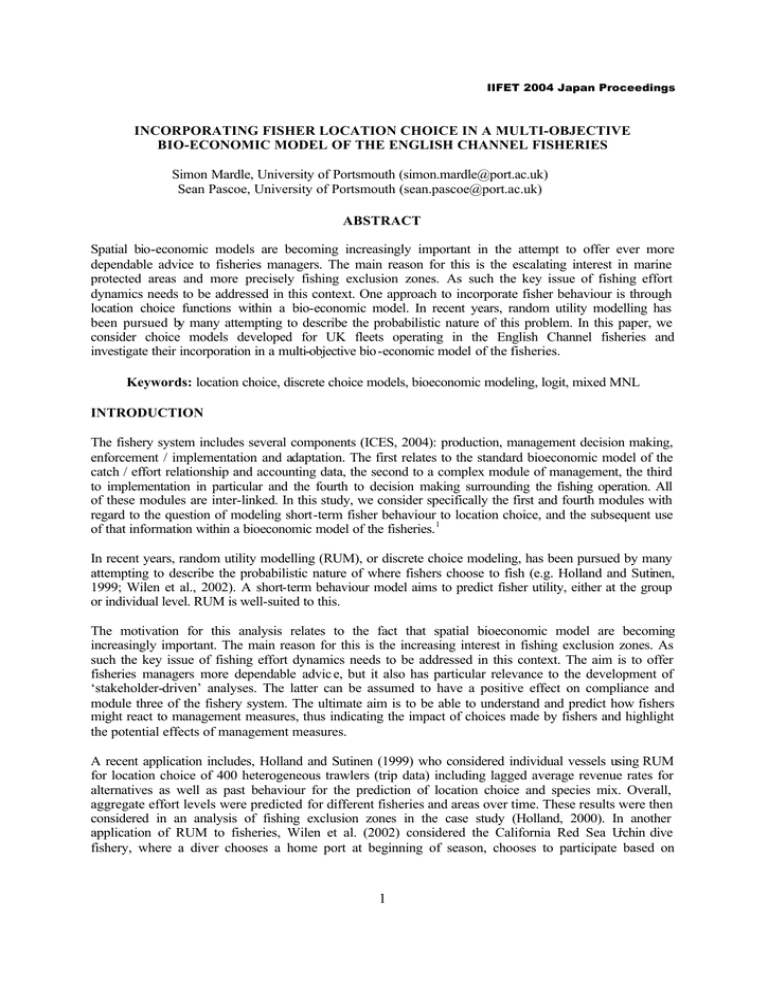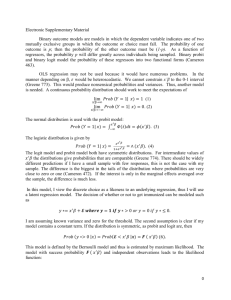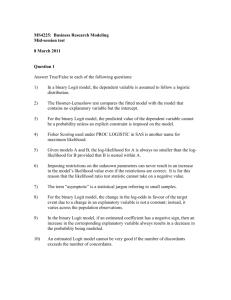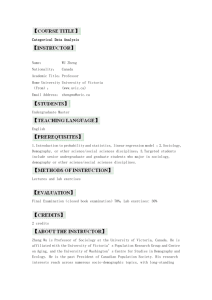INCORPORATING FISHER LOCATION CHOICE IN A MULTI-OBJECTIVE
advertisement

IIFET 2004 Japan Proceedings INCORPORATING FISHER LOCATION CHOICE IN A MULTI-OBJECTIVE BIO-ECONOMIC MODEL OF THE ENGLISH CHANNEL FISHERIES Simon Mardle, University of Portsmouth (simon.mardle@port.ac.uk) Sean Pascoe, University of Portsmouth (sean.pascoe@port.ac.uk) ABSTRACT Spatial bio-economic models are becoming increasingly important in the attempt to offer ever more dependable advice to fisheries managers. The main reason for this is the escalating interest in marine protected areas and more precisely fishing exclusion zones. As such the key issue of fishing effort dynamics needs to be addressed in this context. One approach to incorporate fisher behaviour is through location choice functions within a bio-economic model. In recent years, random utility modelling has been pursued by many attempting to describe the probabilistic nature of this problem. In this paper, we consider choice models developed for UK fleets operating in the English Channel fisheries and investigate their incorporation in a multi-objective bio-economic model of the fisheries. Keywords: location choice, discrete choice models, bioeconomic modeling, logit, mixed MNL INTRODUCTION The fishery system includes several components (ICES, 2004): production, management decision making, enforcement / implementation and adaptation. The first relates to the standard bioeconomic model of the catch / effort relationship and accounting data, the second to a complex module of management, the third to implementation in particular and the fourth to decision making surrounding the fishing operation. All of these modules are inter-linked. In this study, we consider specifically the first and fourth modules with regard to the question of modeling short-term fisher behaviour to location choice, and the subsequent use of that information within a bioeconomic model of the fisheries. 1 In recent years, random utility modelling (RUM), or discrete choice modeling, has been pursued by many attempting to describe the probabilistic nature of where fishers choose to fish (e.g. Holland and Sutinen, 1999; Wilen et al., 2002). A short-term behaviour model aims to predict fisher utility, either at the group or individual level. RUM is well-suited to this. The motivation for this analysis relates to the fact that spatial bioeconomic model are becoming increasingly important. The main reason for this is the increasing interest in fishing exclusion zones. As such the key issue of fishing effort dynamics needs to be addressed in this context. The aim is to offer fisheries managers more dependable advic e, but it also has particular relevance to the development of ‘stakeholder-driven’ analyses. The latter can be assumed to have a positive effect on compliance and module three of the fishery system. The ultimate aim is to be able to understand and predict how fishers might react to management measures, thus indicating the impact of choices made by fishers and highlight the potential effects of management measures. A recent application includes, Holland and Sutinen (1999) who considered individual vessels using RUM for location choice of 400 heterogeneous trawlers (trip data) including lagged average revenue rates for alternatives as well as past behaviour for the prediction of location choice and species mix. Overall, aggregate effort levels were predicted for different fisheries and areas over time. These results were then considered in an analysis of fishing exclusion zones in the case study (Holland, 2000). In another application of RUM to fisheries, Wilen et al. (2002) considered the California Red Sea Urchin dive fishery, where a diver chooses a home port at beginning of season, chooses to participate based on 1 IIFET 2004 Japan Proceedings weather, prices, expected abundance, diver traits and processor commitments, then chooses dive locations as well as diving hours. The structure of this paper follows. Discrete choice modeling is discussed, followed by an overview of the case study used for analysis. Results are then presented, which is followed by discussion and conclusions. DISCRETE CHOICE MODELLING Several studies in the field of fisheries now exist that implement a random utility methodology (RUM). For the most part, this concerns the prediction of individual fishery and location choice (e.g. Bockstael and Opaluch, 1983; Eales and Wilen, 1986; Holland and Sutinen, 1999; Wilen et al., 2002). There has been considerable application to recreational fisheries, however the last two in particular describe applications to sea fisheries. To quote Wilen et al. (2002; p.556), “economists believe that an advantage to using micromodels of individual behaviour that incorporate structure… is that they can predict responses to policies that have not been in place over the sample period used to estimate (the) response elasticities”. Key facets of RUM are that discrete decisions can be modelled, there is no assumption of homogeneity amongst individuals, and as in most economic -based choice models, utility drives individual choice with a deterministic component and a stochastic error component. So, the utility of alternative i is defined as a (linear) combination of a set of explanatory variables that together are surmised to form (for the most part) the non-random components of the utility, and a stochastic error component. The most general form of which can be written as, U ij = β ij z ij + ε ij (1) where for a given person time -event, i, (such as a fishing trip) choice j is made. The explanatory variables zij can be comprised of attributes of the choice, x ij , and characteristics of the individual, wi. Through a choice of distribution on disturbances of the error term, typically logit, then the model can be estimated. The probability of a given choice being made can then be estimated from evaluating (and normalising) the derived utility. Conditional logit (McFadden, 1974; 1981) has long been used for the estimation of these parameters, β. Recently, mixed logit has been gaining favour for location choice analyses in other fields of application. Conditional Logit (McFadden’s choice model) In a conditional logit formulation, a set of unordered choices (e.g. j = 1, 2, …, n) is assumed. So, the probability that individual i makes choice j is given by, Pr(Yi = j ) = exp( z 'ij β ) ∑ J exp( z 'ij β ) j =1 (2) where y i are 0-1 variables indicating 1 where the choice was made and 0 otherwise, and the independent variables zij =[x ij wi ] where x are attributes of choice j of individual i and w are attributes of individual i. The residuals, ε ij, are independently and identically distributed (iid) with the type I extreme-value distribution. The presumption of independence of ε ij leads to the assumption of the property of independence of irrelevant alternatives (IIA). That is, the ratio of any two alternatives will remain the 2 IIFET 2004 Japan Proceedings same irrelevant of other alternatives (this is discussed further in the mixed logit section). In the case where the independent variables consist only of individual attributes, then the multinomial logit results. 2 However, for spatial analyses as experienced in fisheries, Wilen et al. (2002) state that conditional logit is inappropriate as the independence of irrelevant alternatives (IIA) assumption that it imposes could be potentially invalidated and therefore influence policy analyses that consider spatial aspects. IIA implies that a change in the choice set would not affect the relative choice probabilities, as the choices are assumed independent. To take this into account, they use the nested logit model (e.g. McFadden, 1981; Morey et al., 1993) that although in basic structure is the same (but with the imposition of a hierarchical structure on the decision process) does not impose IIA across nests. An alternative to the nested approach, which can be difficult to estimate for more than 3 or 4 hierarchical levels, is the mixed logit model which does not impose IIA but also includes choice attributes and individual characteristics. The clogit procedure in Stata and model clogit in PROC MDC in SAS are two common software routines that can be used. Mixed Logit Mixed logit models have seemingly been around for some time. Train (1999) notes applications in 1980. Their lack of application since, compared to other logit models, is due to the complexity of solution that results. As stated by Train (1999; p.122), “advances in computer speed, as well as our understanding of numerical methods for integration and the structure of mixed logits, have prompted renewed interest”. Mixed logit is handled in detail by Train (2003), however we summarise the formulation below. As noted above, a conditional logit model is used to estimate the probability that an individual, i, chooses alternative, j, from some set of alternatives (equation 1). However, mixed logit generalizes this by allowing the estimated coefficients, β, to be random rather than fixed. So, in this case, the probability (P) that individual, i, chooses alternative, j is estimated using, Pi = ∫ L i ( β ) f ( β ) dβ (3) where Li (β) is the logit function estimated for parameters, β, (as equation 2) and f(β) is a density function on the parameters, β. In this paper, we use the mixed logit model without random-coefficients, but with error components that are correlated amongst the utilities for the alternatives. In this case, utility is given as U i = θx i + µ z i + ε i (4) where x and z are observed variables, θ is a vector of fixed coefficients, µ is a vector of random terms with zero mean and ε is distributed iid extreme value. Hence, if µ is zero then a conditional logit formulation results. In fact, McFadden and Train (2000) showed that any random utility method can be approximated using mixed logit.3 The conditional logit depends on the assumption of IIA. So, this implies that a change in the attributes will not change the ratio of the two alternatives, and moreover will result in the same percentage change across alternatives. Mixed logit does not assume IIA, as the percentage change across alternatives may 3 IIFET 2004 Japan Proceedings vary given changes in attributes. Hence, mixed logit overcomes many of the limitations of conditional logit. Furthermore, extra information is provided by mixed logit over conditional logit. This is due to the fact that mixed logit can estimate the extent to which individuals differ in their preferences for attributes. In the case where coefficients on the standard deviations of observed variables differ significantly, then mixed logit represents the choices made better than conditional logit. This is because it is assumed in conditional logit that coefficients are the same for all individuals. Mixed logit can also take into account several choices made by the same individual. Also, where applicable, willingness to pay for individuals towards changes in attributes can be estimated from a mixed logit solution. As noted previously, mixed logit requires that numerical methods (i.e. simulation) are required for solution. This has the implication that whereas a conditional logit solves in seconds, a mixed logit may take at best minutes or possibly hours to reach solution. Software that has currently has capability for mixed logit includes GAUSS and the MDC procedure in SAS. In fisheries, two studies that have considered a mixed logit variant in the analysis of heterogeneous risk preferences of fishers are Eggert and Tveterås (2003) and Mistaien and Strand (2000).4 THE UK FISHERIES OF THE ENGLISH CHANNEL The English Channel is defined by ICES divisions VIId and VIIe. It contains a number of multi-species multi-gear fisheries dominated by high-value fish and shellfish species such as sole, lobster and scallops. Around 4000 registered boats operate in the fishery ranging in size from 4m to over 30m. The fleet consists primarily of UK and French boats, although a small number of Belgian beam trawlers operate part of the year in the Eastern Channel, and a small fleet from the Channel Islands operate in their adjacent inshore waters. Total employment in the UK component of the fishery was estimated to be about 4,300 excluding indirect employment in industries linked to the fishing industry. In France, about 4,800 are thought to be employed in the fishery. In 1997, the estimated value of landings from the UK and French fleets was approximately €500 million, 60 per cent of which was landed by the French Fleet. Profitability in the UK fleet has generally been low, with economic profits estimated to have been negative over the period 1994/5-1996/7 (Coglan and Pascoe, 2000). In contrast, the French fleet was estimated to have earned positive economic profits in 1997 (Boncoeur and Le Gallic, 1998). A number of distinct fishing activities (termed métiers) in the Channel have been defined, based on country of origin, fishing gear employed and area fished (Tétard et al, 1995). The métiers are broadly based on seven main gear types: beam trawl, otter trawl, pelagic/mid-water trawl, dredge, line, nets and pots. While fleets can also be broadly classified on the basis of their main gear type, they are largely multi-purpose, and operate in several different métiers over the year. Management of the fishery is undertaken at several levels. The European Council imposes total allowable catches (TACs) on several of the key species in the fishery. These are allocated to the individual countries, which manage the uptake of their respective quotas. Over 50 specie s are caught commercially in the Channel, although only 10 are subject to quota control under the CFP. Management of the other species is largely undertaken through controls on the level and use of inputs in the fishery. Entry to the fishery is limited at the national level, with each boat requiring a licence to operate. Restrictions on the use of gear and limitations on access to particular areas of the fishery are imposed at the European, national and regional level. Technical measures imposed under the CFP include minimum mesh sizes for different fishing activities. These are compounded by other restrictions imposed by the national management authorities as well as regional bodies. 4 IIFET 2004 Japan Proceedings Data used for the location choice analysis The beam trawl fleet operating in the Western Channel was used for the location analysis. Catch and effort logbook data for the period 1993-1998 was available that included vessel characteristics such as engine power, size of vessel and home port, and trip (ie. choice) attributes including effort, catch (weight and value) and area fished. The spatial unit used in the logbook data is that of the ICES statistical rectangle, that represents an area of approximately 30 nautical miles square. The most important species to this fleet according to catch value are (from the highest value): sole, cuttlefish, anglerfish, megrim, lemon sole and plaice. So, the beam trawl fleet activity in the Western Channel (i.e. ICES division VIIe) in 1998 was taken as the main year of analysis, with the five previous years (i.e. 1993-97) used to indicate past fishing history. Activity of the beam trawl fleet across the Channel is shown in figure 1. Vessels with less than one month of fishing activity were excluded from the analysis, as were vessels less than ten metres in length 5 and those vessels with missing physical characteristics in the database. Trips were classified by métier and main gear used. Vessel activity was aggregated to the monthly level by rectangle, and all past activity related only to that vessel. In total, 62 vessels were identified fishing in 7 main rectangles in the Western Channel giving 504 monthly observations. Figure 1. UK beam trawl fleet activity in 1998 (inc. effort index). Summary statistics for the beam trawl fleet are shown in table 1. From first view, the fleet appears relatively homogeneous in terms of size of vessel used and accordingly crew employed, as well as age of the vessel. Greater difference is apparent in the power of the vessel. Table 1. Summary stats for the beam trawlers in the sample. Mean Std. Dev. Length 24.95 4.51 Gross Tonnage 106.88 51.17 HP 495.16 243.30 Average Crew 5.35 1.91 Vessel Age 35.96 8.82 A translog production function was estimated for beam trawl activity in VIIe, specified as: 5 IIFET 2004 Japan Proceedings Yit = α G GTi + α H HPi + α D DAYS it + α GG GTi 2 + α HH HPi 2 + α DD DAYS it2 + α GH GTi HPi + α GD GTi DAYS it + α GH HPi DAYS it + ∑ r =1, 6 α r Rr + ∑m =1,11α m M m + uit (5) where Yit is the landing value for vessel i in trip t, GT is vessel capacity in gross tonnage, HP is engine horse power, DAYS is fishing effort converted to hours fished, R is a set of dummy variables for area (i.e. rectangle) fished, M is a set of dummy variables for month and u is the error term. Past studies have concluded that such a translog production function is most suitable to the fisheries in question here (Pascoe and Mardle, 2003). For the analysis value of all variables are logged. The results of this analysis are presented in table 2. The production function is highly significant, with an R2 =0.69. For the most part, variables are significant at the 1% level. The results show a fleet that is seasonal in nature as well as location dependent. Gross tonnage is an important factor in estimating production as would be expected, however effort is not significant which may suggest a lack of heterogeneity within the sample. Table 2. Translog production function results for beam trawl activity in 1998. (Constant) LN_GT LN_HP LN_DAYS LN_GT 2 LN_HP 2 LN_DAYS 2 LN_GTxHP LN_GTxDAYS LN_HPxDAYS a -2.260 8.226*** -3.807** 0.463 -0.035 0.700*** -0.047*** -1.160*** -0.122 0.193** Std. Error 3.960 1.864 1.553 0.424 0.206 0.214 0.017 0.344 0.080 0.078 Rectangles: R1 R2 R3 R4 R5 R6 -0.642** -0.325* -0.471*** -0.583*** -0.398** -0.299* 0.282 0.196 0.172 0.164 0.164 0.164 0.611*** 0.534*** 0.379*** 0.198 0.502*** 0.488*** 0.393*** 0.531*** 0.604*** 0.539*** 0.616*** 0.117 0.123 0.111 0.138 0.137 0.139 0.124 0.122 0.126 0.117 0.128 Months: M1 M2 M3 M5 M6 M7 M8 M9 M10 M11 M12 Note: Dependent variable: ln(total_value); *** significant at 1%, ** 5%, * 10% 6 IIFET 2004 Japan Proceedings LOCATION CHOICE RESULTS First, a conditional logit was implemented for the UK beam trawl fleet operating in the Western Channel. The results for the conditional logit are presented in table 3. The model has an acceptable Likelihood ratio index equal to 0.443. Variables that appear significant to the choice of location fished include distance traveled to the fishing grounds, the expected values of plaice and anglerfish catch, and past fishing history in the area. In particular, it is the activity of that vessel in a rectangle in the past year that is most significant. The negative sign on the distance variable suggests that vessels choose to fish closer to port. It is interesting to note that expected overall revenue as well as expected value of sole and cuttlefish (i.e. the two most ‘important’ species) are not significant in the choice made. Fishing effort in a given area is not included by the model and along with the fact that many of the parameter values are low may suggest a lack of heterogeneity in the sample fleet. Table 3. Conditional logit results. Parameter Estimate Standard Error Expected revenue 3.63E-05 3.27E-05 1.11 0.2669 Length 0.007997 . . . GT -0.00018 . . . -0.0269 0.003318 -8.1 <.0001 Days Fished 3.27E-05 . . . Days at Sea 9.80E-07 . . . Plaice value 0.000912 0.000194 4.7 <.0001 Anglerfish value 0.00052 0.000118 4.41 <.0001 Cuttlefish value 1.71E-05 3.79E-05 0.45 0.6522 Sole value -2.6E-05 4.35E-05 -0.6 0.5503 Other value -0.00012 7.53E-05 -1.59 0.1114 Fished last 5 yrs -0.0603 0.0751 -0.8 0.4224 Fished last year 1.7659 0.2446 7.22 <.0001 Past average vessel effort 0.006875 0.002462 2.79 0.0052 Past average weight -1.9E-05 8.98E-06 -2.12 0.0341 Past average value 8.61E-05 3.06E-05 2.81 0.0049 Distance t Value Approx Pr > |t| Second, a mixed logit was implemented for the UK beam trawl fleet. The results for the mixed logit are presented in table 4. The model has an improved Likelihood ratio index equal to 0.551 over the conditional logit model. This suggests that some heterogeneity exists within the modeled fleet. This is further supported by the fact that many of the standard deviations associated with parameters are significant.6 However, the results offer similar conclusions to those from the conditional logit. That is, distance traveled to fishing grounds is a highly significant variable with negative sign suggesting that fishers choose to fisher closer to port, and past effort in a given rectangle is also highly significant. Expected value of plaice and anglerfish catch are significant, however there are some anomalies in the signs of expected total revenue and expected revenue for sole. The fact that the means are close to zero may be indicative of their lack of relevance to the choice made. In considering the shares in the mixed logit results, it is indicated that only 38% of locations chosen are expected to result in higher revenues. This is probably due to issues concerning the parameter for 7 IIFET 2004 Japan Proceedings expected revenue as discussed above. However, 80% of locations chosen are expected to result in higher plaice catches (53% for anglerfish and only 5% for sole). It may be surmised from this that plaice is a more ‘targetable’ species than sole, even though sole is more valuable. As an aside, fisheries scientists report, that in the Weste rn Channel, sole is currently below sustainable limits. The results also show that distance traveled to fishing grounds is minimised in almost all observations.7 Furthermore, a higher past average value obtained from a given location is evident in 87% of choices (and 77% for past effort). Table 4. Mixed logit results. Parameter Revenue Distance Days Fished Plaice Value Angerfish Value Estimate Standard Error Mean -0.00078 0.000405 -1.93 0.0534 Std.dev. -0.00264 0.000989 -2.67 0.0075 Mean -0.0664 0.025 -2.66 0.0078 Std.dev. -0.0276 0.0275 -1.01 0.3141 Mean 1.00E-06 . . . Std.dev. 1.51E-16 . . . Mean 0.006008 0.002446 2.46 0.014 Std.dev. 0.007084 0.003441 2.06 0.0395 Mean 0.000968 0.001333 0.73 0.4679 -0.014 0.005275 -2.65 0.0081 Mean -0.00109 0.000487 -2.23 0.0255 Std.dev. -0.00064 0.000839 -0.77 0.4438 Mean 0.0719 0.0423 1.7 0.0887 Std.dev. 0.0994 0.0491 2.02 0.043 Mean 0.000215 0.000175 1.23 0.2184 Std.dev. 0.000501 0.000245 2.04 0.0412 Mean 0.001597 0.000748 2.14 0.0328 Std.dev. -0.00144 0.00058 -2.49 0.0129 Std.dev. Sole Value Past Average Effort Past Average Weight Past Average Value t Value Approx Pr > |t| SOME THOUGHTS ON COMBINING LOCATION CHOICE IN A CHANNEL MODEL The Channel fisheries bioeconomic model (Pascoe, 2000) is an equilibrium-based model developed to incorporate the UK and French fishing fleets operating in ICES divisions VIId and VIIe. The current incarnation of the model is described in Mardle et al. (2003) and includes the multiple objectives of management of the fisheries. To summarise, the model is driven by the effort exerted on the fishery in terms of numbers of vessels described by fleet. There are six size classes and six principal gear types (beam trawl, otter trawl, dredge, lines, nets and pots). In total, 55 Channel métiers are explicitly included in the model. A total of 40 species and 53 different stocks are represented in the model, including some that extend beyond the Channel into the North Sea, Irish Sea or Western Approaches. Approximately half of these stocks are modelled by age-structure and half by surplus production models. Catches of each species are estimated based on the level of fishing activity and the relative catchability in a métier. Effort is applied to a métier rather than individual species. Cost and earnings data were derived from economic surveys of the fishery (Boncoeur and Le Gallic, 1998; Coglan and Pascoe, 2000). 8 IIFET 2004 Japan Proceedings Should this structure be translated into a dynamic framework, the incorporation of a choice model within such a structure is well-suited. It is not an individual-based model, but the aggregated results from the choice model could be incorporated directly. The behaviour of fleets with respect to location fished by gear and/or métier can be approximated and factors affecting behaviour estimated. It would be possible to combine this with qualitative information in order to better describe changing fleet activity through choice modeling. The polyvalent nature of the fleets may be handled also, by evaluating similar choice functions for gear switching for example. Perhaps the most difficult part of integrating this information is with the biological interactions (i.e. movement of species). For the Channel model, two main issues exist: stocks extend beyond ICES divisions VIId and VIIe and are not modelled at the ICES rectangle level for the provision of management advice; and that many of the important stocks targeted are not subject to quota restrictions (e.g. cephalopods, crustaceans and shellfish) and hence are potentially not researched in the detail required to provide spatial analyses. This is particularly important for the evaluation of fishing exclusion zones or marine protected areas. In a dynamic framework, including behaviour such as location choice validates assumptions used and enables an integrated fisheries system approach, even in a reduced form. However, unsurprisingly spatiality is the key in this situation. Catch data is recorded in logbooks at the ICES rectangle level. To model catch at a finer detail in what has been described as almost artisanal fisheries such as the Channel (Boncoeur and Le Gallic, 1998) would be difficult. However, with qualitative information through surveys, then perhaps more detail surrounding vessel movements can be approximated. One approach might be to identify ‘hot-spots’ within a rectangle. DISCUSSION AND CONCLUSIONS Random utility modeling methodology is clearly an effective way of measuring short-term choice behaviour of fishers to situations such as location choice. This is evident from the many applications that are appearing in the literature. Preliminary results of the analysis for the beam trawl fleet highlighted validates the assumption that past history (including past revenues) is followed for location choice as well as distance traveled to fishing grounds. This is in common with results found in other analyses using RUM (e.g. Holland and Sutinen, 1999; Wilen et al., 2002; Mardle and Hutton, 2004). This study has not attempted to investigate risk aversion or risk attraction of fishers, however Eggert and Tveterås (2003) did using the expected standard deviation of revenue. Several avenues for investigation have arisen. In the RUM analysis, qualitative information is not included, and it may be that this could improve understanding or prediction of location choice. It was noted by Holland and Sutinen (1999) that many of the ‘rules’ used by fishers are not picked up in such an analysis. A conclusion of the study by Mardle and Hutton (2004) for the beam trawl fleet operating in the North Sea was that there is probably a natural choice for fishers on where to fish given the vessel that they operate (i.e. a capital investment to operate in a specific locality). Although some heterogeneity in the choices of fishers are apparent, perhaps the spatial detail used but more importantly the lack of variation in the data (particularly for effort) is responsible. Utility derived for choices made does not necessarily reveal heterogeneity in choices that might or should be expected, how ever using trip data with some qualitative information may better reflect the system. The question of using conditional logit (and nested logit) over mixed logit is a difficult one. Studies exist for each in the literature: nested logit (Holland and Sutinen, 1999; Wilen et al., 2002), mixed logit (Eggert 9 IIFET 2004 Japan Proceedings and Tveterås, 2003; Mistainen and Strand, 2000). The additional features of mixed logit make it attractive, both in terms of its generality and the information it provides. The capability of exploring heterogeneous preferences of fishers in particular makes mixed logit highly applicable to fisheries. However, it has been shown that relaxing the IIA assumption (i.e. using a using either a conditional logit or mixed logit model) does not generally lead to dif ferent conclusions being drawn from results (Dahlberg and Eklöf, 2003). This implies that in location choice (in its most general sense, not just fisheries), the hypothesis of fixed coefficients is a valid one. The use of RUM results in bioeconomic models is a practical approach to incorporating short-term choice behaviour into models of the dynamics of fisheries. The robustness of the RUM approach and the practicality of bioeconomic models are well-suited (given the usual caveats!). ACKNOWLEDGEMENTS The authors would like to acknowledge funding made available by the European Commission under 5th Framework project Q5RS-2002-01291, “Technological developments and tactical adaptations of important EU fleets (TECTAC)”, and support of the Department for the Environment, Food and Rural Affairs, UK under the project “Cost-benefit analysis in the South-West (COBAS)”. REFERENCES Bockstael, N.E. and J.J. Opaluch, 1983, Discrete modelling of supply response under uncertainty: The case of the fishery, Journal of Environmental Economics and Management, 10(2), pp.125-137. Boncoeur J. and B. Le Gallic, 1998, Economic survey of the French fleet operating the English Channel fisheries, CEDEM, University of Western Brittany, Brest (France). Coglan, L. and S. Pascoe, 2000, Economic and financial performance of the UK English Channel fleet, 1994-95 to 1996-97. CEMARE Research Report 150, University of Portsmouth, UK,. Dahlberg, M. and M. Eklöf, 2003, Relaxing the IIA assumption in locational choice models: A comparison between conditional logit, mixed logit and multinomial probit models, Dept. of Economics, Uppsala University, PO Box 513, SE-751 20 Uppsala, Sweden. Eales, J. and J.E. Wilen, 1986, An examination of fishing location choice in the pink shrimp fishery, Marine Resource Economics 2(4): 331-351. Eggert, H. and R. Tveterås, 2003, Stochastic production and heterogeneous risk preferences: Commercial fishers’ gear choices, American Journal of Agricultural Economics 86(1): 199-212. Greene, W.H. 2003, Econometric Analysis, 5th Edition, Prentice-Hall: USA. Holland, D.S. 2000, A bio-economic model of marine sanctuaries on Georges Bank, Canadian Journal of Fisheries and Aquatic Science, 57(6), pp. 1307-1319. Holland, D.S. and J.G. Sutinen, 1999, An empirical model of fleet dynamics in New England trawl fisheries, Canadian Journal of Fisheries and Aquatic Science, 56, pp. 253-264. Holland, D.S. and J.G. Sutinen, 2000, Location choice in New England fisheries: Old habits die hard, Land Economics, 76(1), pp. 133-149. ICES, 2004, Working Group on Fishery Systems Report, International Council for the Exploration of the Sea, Copenhagen, Denmark. McFadden, D. 1974, Conditional logit analysis of qualitative choice behavior, In: Frontiers in Econometrics, P.Zarembka (ed.), pp. 105-142, New York: Academic Press. McFadden, D. 1981, Econometric models of probabilistic choice, In: Structural Analysis of Discrete Data with Econometrics Applications, C.F.Manski and D.McFadden (eds.), pp. 198-272, Cambridge US: MIT Press. 10 IIFET 2004 Japan Proceedings McFadden, D. and K.E. Train, 2000, Mixed MNL models of discrete response, Journal of Applied Econometrics 15:447-470. Mardle, S. and T.P. Hutton, 2004, Measuring the effects of distance to fishing grounds in location choice modelling. Presented at the XVIth Conference of the European Association of Fisheries Economists (EAFE), 5-7 April, 2004, Rome, Italy. Mardle, S., S. Pascoe, J. Boncoeur and B. Le Gallic, 2003, Analysing stakeholder preferences on multiple objectives in a bioeconomic model of the fisheries of the English Channel, Proceedings of the 11th Biennial Conference of the International Institute of Fisheries Economics and Trade (IIFET), August 19-22, 2002, Wellington, NZ. Mistiaen, J.A. and I.E. Strand, 2000, Location choice of commercial fishermen with heterogeneous risk preferences, American Journal of Agricultural Economics 82(5): 1184-1190. Morey, E.R., R.D. Rowe and M. Watson, 1993, A repeated nested-logit model of Atlantic salmon fishing, American Journal of Agricultural Economics, 75(August), pp. 578-592. Pascoe S. (Ed.), 2000, Bioeconomic modelling of the fisheries of the English Channel, FAIR CT 96-1993, Final Report, CEMARE research report n°53, pp. 142. Pascoe, S. and S. Mardle (Eds.) 2003. Single output measures of technical efficiency in EU fisheries. CEMARE Report 61, University of Portsmouth, UK: pp. 208. (ISBN 1-86137-306-6) Tétard, A., M. Boon et al., 1995, Catalogue international des activités des flottilles de la Manche, approche des interactions techniques, Brest, France: IFREMER. Train, K.E. 1999, Mixed logit models for recreation demand, In: J.A. Herriges and C.L. Kling (Eds.), Valuing Recreation and the Environment (Revealed Preference Methods in Theory and Practice), Edward Elgar Publishers, Massachusetts, USA. Train, K.E. 2003, Discrete Choice Methods with Simulation, Cambridge University Press, UK. Wilen, J.E., M.D.Smith, D. Lockwood and F.W. Botsford, 2002, Avoiding surprises: Incorporating fisherman behavior into management models, Bulletin of Marine Science, 70(2), pp. 553-575. ENDNOTES 1 Other short-term behaviour that may be considered in this context include discard practices and utilization of effort (e.g. gear choice). 2 See McFadden (1974) and Greene (2003) for more details. 3 Particularly important for fisheries, nested logit can be approximated by specifying dummies in a mixed logit formulation. 4 These authors used the term random parameters logit. Vessels less than ten metres in length are not required to submit logbooks, hence this information could not be validated as part of this study. 5 6 For the case where coefficient values for standard deviations are non-significant or zero then a conditional logit would be approximated. 7 It should be noted that an area fished in this model is equivalent to about 30 nm2, which is not necessarily detailed enough for a fisher making a decision of where to fish, however it is indicative of their fishing operation. 11






